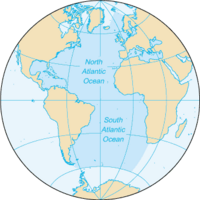
Photo from wikipedia
Abstract Paleoceanographical changes during the Holocene were reconstructed from the study of core MD95-2002 situated in the northern Bay of Biscay, which is marked by the direct influence of the… Click to show full abstract
Abstract Paleoceanographical changes during the Holocene were reconstructed from the study of core MD95-2002 situated in the northern Bay of Biscay, which is marked by the direct influence of the northeastern return branch of the North Atlantic Drift. Palynological data, sea-surface condition estimates based on dinocyst assemblages and stable isotope measurements in planktic and benthic foraminifera reveal a strong influence of freshwater/meltwaters from both the proximal European sources and the more distal Laurentide Ice Sheet, which experienced delayed deglaciation. The data also indicate the setting of a climate optimum between 7 and 5.5 ka followed by a cooling trend, which is consistent with insolation changes and other regional records of climate changes. Superimposed on the long term trends, the reconstructions of sea-surface conditions evidence large amplitude changes at centennial to millennial time-scales, with seven episodes of cooling and low salinity since 11 ka that generally match episodes of dense sea-ice cover in the Labrador Sea. The west to east transfer of the sea-ice and/or meltwater signal across the North Atlantic evidenced from core MD95-2002 points to strong linkages between western and eastern North Atlantic, probably in relation to the North Atlantic Oscillation (NAO) mode of variability.
Journal Title: Palaeogeography, Palaeoclimatology, Palaeoecology
Year Published: 2017
Link to full text (if available)
Share on Social Media: Sign Up to like & get
recommendations!